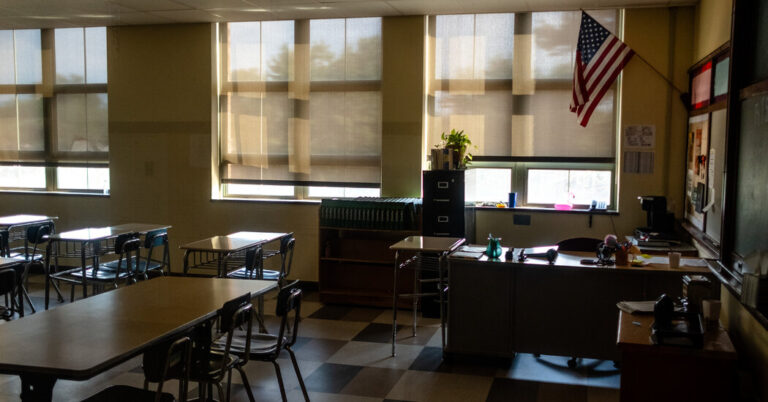
[ad_1]
National test scores released on Wednesday showed a marked drop in students’ knowledge of U.S. history and a modest decline in civics, a sign of the pandemic’s alarming reach, damaging student performance in nearly every academic area.
The pandemic plunge in U.S. history accelerated a downward trend that began nearly a decade ago, hitting this recent low at a time when the subject itself has become increasingly politically divisive.
A growing number of students are falling below even the basic standards set out on the National Assessment of Educational Progress, a rigorous national exam administered by the Department of Education. About 40 percent of eighth graders scored “below basic” in U.S. history last year, compared with 34 percent in 2018 and 29 percent in 2014.
Just 13 percent of eighth graders were considered proficient — demonstrating competency over challenging subject matter — down from 18 percent nearly a decade ago.
Questions ranged from the simple — knowing that factory conditions in the 1800s were dangerous, with long days and low pay — to the complex. For example, only 6 percent of students could explain in their own words how two ideas from the Constitution were reflected in the Rev. Dr. Martin Luther King Jr.’s “I Have a Dream” speech.
The dip in civics performance was smaller but notable: It was the first decline since the test began being administered in the late 1990s. About 22 percent of students were proficient, down from 24 percent in 2018.
President Biden’s education secretary, Miguel A. Cardona, seized on the results, admonishing politicians for trying to limit instruction in history, often on topics of race, a trend that has played out in dozens of states, typically Republican controlled.
“Now is not the time,” he said, adding that “banning history books and censoring educators from teaching these important subjects does our students a disservice and will move America in the wrong direction.”
The results, from a national sample of about 8,000 eighth graders in each subject, track with scores in math and reading, which also decreased during the pandemic. Across subjects, declines were often driven by the lowest-performing students, a trend that has federal officials so concerned that they are now considering rewriting test questions to zero in on what these students are missing.
In history, it’s possible that reduced reading comprehension played some role in student performance.
But experts also pointed to a continuing de-emphasis on social studies instruction.
Since the implementation of No Child Left Behind in the early 2000s and its update during the Obama administration, federal policy has required states to test students in reading and math. Periodic testing is also required for science.
No such mandate exists for social studies. (Many state policies around testing and accountability also do not include social studies.)
While some experts have criticized standardized tests as limited in effectiveness and detrimental to students, most generally agree: What is tested drives what is taught.
Instructional time for social studies declined after the implementation of No Child Left Behind, a pattern that was amplified during the pandemic, when schools had to triage academic losses, resulting in more of a focus on reading and math.
“It doesn’t bode well for the future of this country and for the future of democracy if we don’t start doing more instruction in social studies,” said Kristin Dutcher Mann, a history professor at the University of Arkansas at Little Rock, who helps train middle and high school social studies teachers. At one point, she said, older elementary school students in her community received an hour of social studies each day. Now, she said, “they will be lucky if they get 30 minutes for social studies twice a week.”
(The National Council for the Social Studies recommends a minimum of 45 minutes of daily instruction in elementary school and a similar equivalent in middle and high school.)
Instruction has changed, too.
Students spend far less time memorizing state capitals or the preamble to the Constitution — information they could easily Google — and instead focus more on key skills, like distinguishing between primary and secondary source documents. That’s not necessarily a bad thing, Dr. Dutcher Mann said. Students need to be taught to think critically.
But she said that emphasis can contribute to a troubling lack of background knowledge. Even in her college classes, she said, she has noticed a “rapid and very significant decline” in what students know about history and geography — like the fact that Africa is a continent, not a country.
A base knowledge in history and civics is critical for students to become engaged, informed citizens, particularly amid misinformation on social media platforms, said Kei Kawashima-Ginsberg, director of Tufts University’s CIRCLE center, an organization focused on youth civic engagement.
She cited a recent TikTok campaign against an Alaska oil project, which resulted in a misguided petition urging President Biden not to sell Alaska.
“You need some basics to understand what’s even verifiable: ‘Does it even jibe loosely with what I learned?’” she said, noting that the president does not have executive power to sell a state.
With American trust in institutions falling to new lows, but with young voter turnout and political engagement up, many see this as a pivotal moment for re-emphasizing history and civics education.
Sheila Edwards, a middle school history teacher in Los Angeles County, said after recent school shootings, students had inundated her with detailed questions about the Second Amendment. On the day of the Jan. 6 attack on the Capitol, she had to come up with a new homework assignment to address her students’ interest in the news.
“Kids seem to be more interested in history and civics than ever before,” she said.
[ad_2]